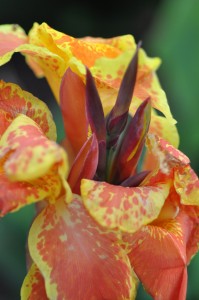
Between last year’s excessive drought and our increasingly warmer temperatures, it’s easy to feel discouraged about your landscape. Knowing these spring rains aren’t likely to last, many gardeners are dreading their first water bill, and think their only choice is to switch to a desert-style garden filled with rocks and cacti.
Not so.
Do you find yourself wishing for a lush, green garden in the middle of our hot summers? Will the hot temperatures have you longing for a tropical paradise – someplace with bold, exotic plants and hot colors? If you can’t afford to fly off to an island, you can create a tropical-looking garden right here in Central Texas using native or adapted drought-tolerant plants.
True tropical plants are wild plants from the equatorial areas bordered by the Tropic of Cancer to the north and the Tropic of Capricorn to the south. Inside this swath around the center of the earth, tropical plants live in both cool upland environments, and in hot, steamy lowlands.
You might not be able to plant many of the same plants, but you can improvise, using similar shapes, textures and color combinations to capture the illusion of paradise.
While the plants you use play a significant role in defining the style of your landscape, there are many other design elements used to help create specific garden types. Color, texture, form, line and scale – the five elements of landscape design – all play a role in crafting your garden. How you place and prune your plants is also a factor affecting the end result.
Line
Soft, curved lines provide drama and expression in the garden and lend themselves to a tropical design more than straight lines when used in borders and paths. They are much more informal and natural.
Form
The natural shape of plants is the primary determinant of whether a landscape is formal or informal. Tropical plants commonly have large, broad leaves and lush foliage that is very naturalistic – sprawling or flowing like palms – and rarely pruned into any sort of predetermined shape.
Texture
This is how coarse or fine the surface of a plant feels and looks. Plants with coarse texture have larger, irregular leaves, thick veins or rough bark like agaves, philodendron or leather leaf mahonia. Fine-textured plants have thin, strappy leaves like grasses or vines. Most tropical gardens include medium to coarse-textured plants with mid-sized leaves and smooth shapes like banana trees, cordylines, agaves or cannas.
Scale
Scale refers to the relative size of plants and other garden elements to the house or patio or the property as a whole. Tropical gardens generally use a larger scale than other garden styles. The plants are bigger and bolder and more plants are grouped closely together for a dramatic feel. The goal is to create a jungle-like effect of dense plantings with many vertical layers. Enormous plants with gigantic leaves also bring a sense of fun into the garden with their almost-absurd scale.
Color
The most powerful design element in establishing a tropical feel is color. Bright, hot colors with great contrast work best. Try pairing colors on opposite sides of the color wheel like purple and yellow or burgundy and lime green. In tropical gardens, foliage is usually the star player year-round. Dramatic variegated foliage with contrasting stripes and bands of color often command your attention before the blooms.
Your hardscape and garden decor can also impart a tropical style – with hot colored cushions, bamboo or rattan furniture, bright nylon outdoor rugs and even a water feature – you can imagine yourself on that island far away.
Getting a tropical look with drought tolerant plants
There are many native and adapted plants that will tolerate our harsh Central Texas summers and still give you the feel of a lush, tropical garden.
For example, native palms and hibiscus like Moy Grande or Texas Star are varieties that will do well in our heat but still look and feel like steamy, tropic-loving varieties.
- variegated ginger
- esperanza
- sago palms
- agapanthus
- bougainvillea
- elephant ears
- coleus
- sabal minor or palmetto palm
- bananas
- fatsia
- cordyline
- philodendrun
- fern
- croton
- agaves
- Spanish dagger
- plumeria
- duranta
- potato vine
- crinum lily
- variegated yucca
- shrimp plant
- amaranth
- bamboo (clumping to prevent spreading)
- purple heart
- bamboo muhly
- castor bean
- persian shield
Containers
Containers can also provide spots of hot, tropical color on your patio with dramatic color combinations. Tall plants like variegated dracena or cannas make great thrillers and could be combined with coleus for the middle layer of fillers, followed by trailing neon-green potato vine for the spiller. Several pots with vibrant tropical combinations could easily transform your entire patio.
So, try some hot color combos with bold plants this summer and let yourself drift away to a tropical garden paradise.


